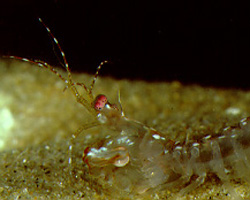Kristina Mead

I look at how stomatopods (mantis shrimp) use their antennules to investigate distant odor sources such as potential prey or future mates. This is part of a large project examining the structures and motions that sample water-borne odors most effectively. Stomatopods are great animals for this study because their chemosensory structures have a relatively simple morphology, and because most species have a very large size range of adults. I used scanning electron microscopy to examine and measure the chemosensory hairs (aesthetascs) from small, medium, and large Gonodactylus mutatus. As the animals increased in size, the aesthetascs got longer and wider. This is somewhat unusual; in other crustaceans, aesthetascs are over-dimensioned in small animals.
To investigate antennule kinematics, Mike O'Donnell and I put animals ranging from 8.4 mm to 52 mm in length into artificial burrows and filmed them using high-speed video. We used brine shrimp odor to stimulate the stomatopod's smelling response. I digitized the images and found that antennule flicking velocity increases with body size. The combined changes in aesthetasc size and in antennule tangential velocity cause the Reynolds number (Re) that describes flow around an aesthetasc during a flick to increase 9-fold as the animals grow from small juveniles to large adults. The increase in Re means that adult aesthetasc arrays are more easily penetrated by fluid (and odorants in the fluid) than juvenile aesthetasc arrays. I used these Re's to build large, dynamically scaled physical models of the juvenile and adult aesthetasc arrays. I dragged the models through a large tank of a viscous liquid seeded with marker particles and illuminated with a laser light sheet. I filmed the particles as they streamed around the models and calculated the flow fields around the aesthetascs. Mark Stacey, Mimi Koehl, and I are currently using these flow fields in an advection diffusion model that calculates how many odorant molecules arrive at aesthetasc surfaces. Among other results, we have found that juveniles and adults use different olfactory strategies. In a side project, Jonathan Fong and I are using behavioral techniques (such as Y-mazes) to study how stomatopods track odor plumes. Eventually, we will test odor plume tracking in a large flume at Stanford. I am also working with Jody Chuang to examine the effects of ambient temperature and water velocity on flick speed and frequency.
Publications
- Mead, K.S. (1998) The biomechanics of odorant access to aesthetascs in the grass shrimp Palaemonetes vulgaris. Biol. Bull. 195: 184-185
- Mead, K.S., M.A.R. Koehl, and M.J. O'Donnell (1999) Stomatopod sniffing: the scaling of chemosensory sensillae and flicking behavior with body size. J. Exp. Mar. Biol. Ecol. 241: 235-261
- Mead, K.S. and M.A.R. Koehl (2000) Stomatopod antennule design: the asymmetry, sampling efficiency, and ontogeny of olfactory flicking. J. Exp. Biol. 203: 3795-3808
- Stacey, M., K.S. Mead, and M.A.R. Koehl (2002) Molecule capture by olfactory antennules: Mantis shrimp. J. Math. Biol. 44: 1-30.
- Mead, K.S. and T.M. Weatherby (2002) The morphology of stomatopod chemosensory sensilla facilitates fluid sampling. Inv. Biol. 121: 148-157
- Mead, K. S. (2002) From odor molecules to plume tracing: an interdisciplining, multilevel approach to olfaction in stomatopods. Integ. and Comp. Biol. 42: 258-264
- Mead, K. S. (2002) Using lobster noses to inspire robot sensor design. Trends in Biotechnology 20: 276-277 (DOI: 10.1016/S0167-7799(02)01979-0)
- Mead, K.S., M.B. Wiley, M.A.R. Koehl, and J.R. Koseff (2003) Fine-scale patterns of odor encounter by the antennules of mantis shrimp tracking turbulent plumes in wave-affected and unidirectional flow. J. Exp. Biol. 206: 181-193
